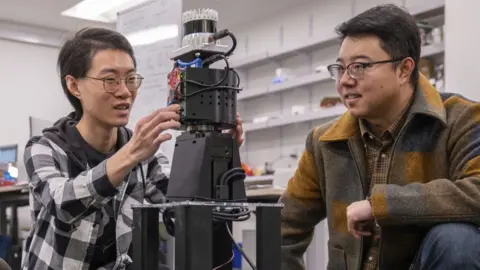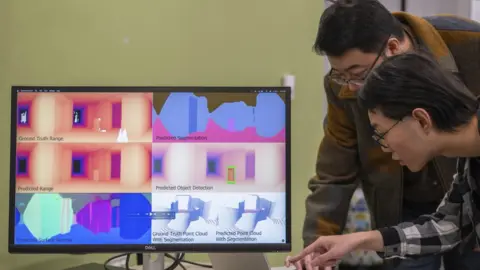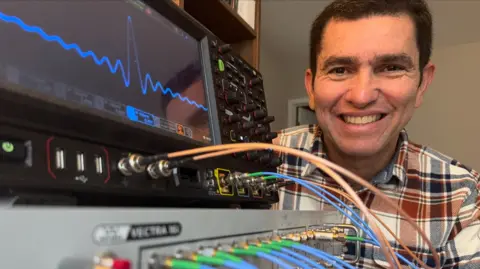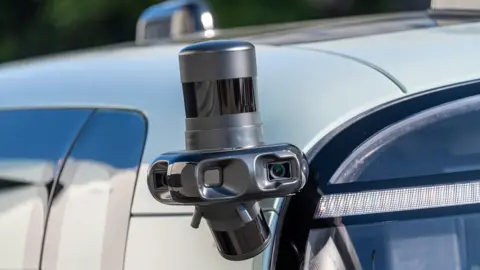Technology reporter
 Sylvia Zhang
Sylvia ZhangIf you want to find out if your robot can see through smoke, well, you will need some smoke.
But a student at the University of Pennsylvania was shocked when they began to create a late night experiment to try such a robot.
Immediately after tweaking the key in the smoke machine, a loud alarm was extinguished.
“The whole building was driven,” says Mingmin Zhao of the University of Pennsylvania, smiling. “My student called me. He was very surprised.”
The incident was a small obstacle for the team that developed a robot equipped with an innovative radio -based sensitization system.
Radio waves can allow robots or autonomous vehicles to see through thick smoke, hard rain – or even around the corners. Such waves can even detect hidden weapons.
But the simulation of visual images based on radio waves is an unusual approach for robots and autonomous vehicles. Much more located in those fields are regular optical cameras, discoveries of light and varying (lidar) and other sensors.
However, Prof Zhao and his students have developed a potentially powerful way for robots to see using radio waves.
Of course the radar, which uses radio waves, has been used for decades to follow planes, ships and weather.
But the rotating group in Prof Zhao’s robot cast radio waves in all directions.
An artificial onboard intelligence system (AI) then builds a 3D environmental view with this information.
“What we have tried to do here is essentially helping robots get superhuman vision – to see in scenarios where human eyes or traditional visual sensors cannot,” explains Prof Zhao.
He suggests that technology can help a future robot of search and rescue, save people from a burnt building.
Subsequent bot tests used a clear plastic box full of smoke placed around its rotating equipment in order to avoid stirring any nearby fire alarm.
 Sylvia Zhang
Sylvia ZhangAlthough people cannot see them, radio waves are a form of light in the sense that they are part of the electromagnetic spectrum, which also includes X -rays and gamma rays. Only a small part of the spectrum is classified as visible light.
Being light, radio waves can reflect surfaces and materials, though in a slightly different way for visible light. Prof Zhao and his colleagues have designed their robot so they can understand these Radio wave reflections.
The essential factor here is that radio waves are much longer than visible light waves which means they are not blocked by small smoke particles.
Prof Zhao says he has also worked on adapting technology so that the robot can see a part of the road around a corner. Think about it as a mirror hall, he suggests, only for radio waves than the visible light.
“Workshta really very interesting and very impressive work,” says Friedemann Reinhard at the University of Rostock in Germany, who was not involved in the job. In 2017, Prof Reinhard and colleagues described how Wi-Fi signals can allow spies to see in private rooms.
A small restriction is that the rotating group cannot see, as defined, in all directions immediately. Prof Reinhard says that a lot of data processing performed by the system seems necessary to clear the resulting image from this rotating device.
However, the robot sends radio waves to the millimeter wave wave (waves that are long between one and ten millimeters). This is the same technology used for some 5G installations.
“This is potentially very attractive, it’s a very understandable, cheap technology,” says Prof Reinhard. “I would of course like to see a car that drived the car by driving only radar.”
 SHAKING
SHAKINGBut it is possible to avoid the use of equipment that emit rotational radio to get a full view, says Fabio da Silva, the founder and chief executive of the US firm Wavns, which is also developing radio -based sensual technology.
“We created an algorithm that allows you to feel all the space immediately and constantly, so we don’t need to rotate our antennas,” he says.
He describes the system as similar to the ecolocation, used by the bats. It sends radio waves and “hears” how the waves turn, which reveals the shape of everything that has hit.
Some researchers have used radio waves to Discover the hidden weapons such as hidden pistols and knives.
Radio waves can even “track finger” details of a room. Then, if scanned again later, this would find out if any object in the room is moved.
Last year, Scientists in Germany proposed that countries use this method to consider the management of other nuclear weapons. It would be a way to know if someone had moved the heads of the war around, for example.
 Getty Images
Getty ImagesSeparately, Luana Olivieri at Loughborough University has explored using a different form of non -visible electromagnetic radiation, terrahertz waves. These are shorter than radio waves but longer than visible light waves. “This wavelength is especially unexplained,” says Dr. Olivieri.
It is possible to see through objects and analyze the materials using this form of radiation, she adds. Such an even system, in theory, could identify specific medicines by detecting their chemical structure.
But while looking through the materials can help a rescue bot find a person trapped in some future disasters, he also has other applications. Police forces and militaries have access to radio -based technology This allows them to see through doors and walls, to some extent.
“Involving war is definitely a market for which it suits. It can be used to find and kill someone,” says Mr. Da Silva. He has exhibited Wavsens technology in the US Department of Defense and the Israeli Ministry of Defense, he says.
And yet, these applications are not completely startling, suggests Prof Reinhard, who shows that a variety of developing technologies, in principle, have made it easier to detect and attack people.
“Maybe radar sounds scary – but free drones and cameras are a much more dangerous thing,” he says.
